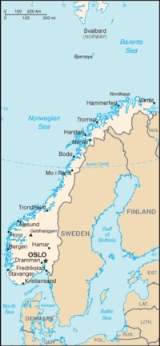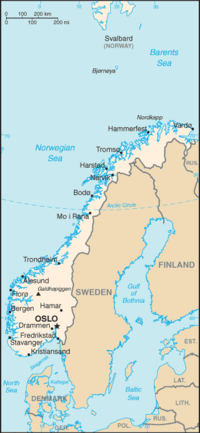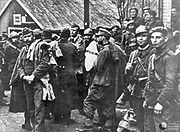
Plan R 4
Encyclopedia

World War II
World War II, or the Second World War , was a global conflict lasting from 1939 to 1945, involving most of the world's nations—including all of the great powers—eventually forming two opposing military alliances: the Allies and the Axis...
British plan for an invasion of the neutral state of Norway
Norway
Norway , officially the Kingdom of Norway, is a Nordic unitary constitutional monarchy whose territory comprises the western portion of the Scandinavian Peninsula, Jan Mayen, and the Arctic archipelago of Svalbard and Bouvet Island. Norway has a total area of and a population of about 4.9 million...
in April 1940. Earlier the British had planned a similar intervention with France during the Winter War.
Background
Germany did not have a sufficient domestic supply of ironIron
Iron is a chemical element with the symbol Fe and atomic number 26. It is a metal in the first transition series. It is the most common element forming the planet Earth as a whole, forming much of Earth's outer and inner core. It is the fourth most common element in the Earth's crust...
ore, used in the production of steel
Steel
Steel is an alloy that consists mostly of iron and has a carbon content between 0.2% and 2.1% by weight, depending on the grade. Carbon is the most common alloying material for iron, but various other alloying elements are used, such as manganese, chromium, vanadium, and tungsten...
. During peace time large quantities of iron ore were imported from mines in the French province of Lorraine
Lorraine (région)
Lorraine is one of the 27 régions of France. The administrative region has two cities of equal importance, Metz and Nancy. Metz is considered to be the official capital since that is where the regional parliament is situated...
. Since September, 1939, this supply was no longer available. So shipments from the other large supplier, Sweden, were essential for the production of tanks, guns, ships, rail cars, trucks and other implements of war. The northern part of the Baltic Sea
Baltic Sea
The Baltic Sea is a brackish mediterranean sea located in Northern Europe, from 53°N to 66°N latitude and from 20°E to 26°E longitude. It is bounded by the Scandinavian Peninsula, the mainland of Europe, and the Danish islands. It drains into the Kattegat by way of the Øresund, the Great Belt and...
, called the Gulf of Bothnia
Gulf of Bothnia
The Gulf of Bothnia is the northernmost arm of the Baltic Sea. It is situated between Finland's west coast and Sweden's east coast. In the south of the gulf lie the Åland Islands, between the Sea of Åland and the Archipelago Sea.-Name:...
, had a principal Swedish port called Luleå
Luleå
- Transportation :Local buses are run by .A passenger train service is available from Luleå Centralstation on Sweden's national SJ railway service northbound to Narvik on the Norwegian coast, or southbound to Stockholm. See Rail transport in Sweden....
from where in the summer a quantity of ore was shipped. It was frozen in winter, so for several months each year the Swedes shipped most of their iron ore by rail through the ice-free port of Narvik
Narvik
is the third largest city and municipality in Nordland county, Norway by population. Narvik is located on the shores of the Narvik Fjord . The municipality is part of the Ofoten traditional region of North Norway, inside the arctic circle...
, in the far north of Norway. In a normal year, 80% of the iron ore was exported through Narvik. The only alternative in winter was a long rail journey to Oxelösund
Oxelösund
Oxelösund is a locality and the seat of Oxelösund Municipality in Södermanland County, Sweden with 10,843 inhabitants in 2005.- History :The harbour at Oxelösund has been used for at least 500 years. In the 19th century, an increased extraction from the Mining district of Central Sweden , made...
on the Baltic, south of Stockholm
Stockholm
Stockholm is the capital and the largest city of Sweden and constitutes the most populated urban area in Scandinavia. Stockholm is the most populous city in Sweden, with a population of 851,155 in the municipality , 1.37 million in the urban area , and around 2.1 million in the metropolitan area...
, which was not obstructed by ice. But, British information suggested that Oxelösund could ship only one fifth the weight Germany required.

The Allies devised a plan to use the Soviet Union November 30, 1939, attack on Finland
Winter War
The Winter War was a military conflict between the Soviet Union and Finland. It began with a Soviet offensive on 30 November 1939 – three months after the start of World War II and the Soviet invasion of Poland – and ended on 13 March 1940 with the Moscow Peace Treaty...
as a cover for seizing both the important Swedish
Sweden
Sweden , officially the Kingdom of Sweden , is a Nordic country on the Scandinavian Peninsula in Northern Europe. Sweden borders with Norway and Finland and is connected to Denmark by a bridge-tunnel across the Öresund....
ore fields in the north, and the Norwegian harbors through which it was shipped to Germany.
The plan was to get Norwegian and Swedish permission to send an expeditionary force
Expeditionary warfare
Expeditionary warfare is used to describe the organization of a state's military to fight abroad, especially when deployed to fight away from its established bases at home or abroad. Expeditionary forces were in part the antecedent of the modern concept of Rapid Deployment Forces...
to Finland across northern Norway and Sweden, ostensibly to help the Finns. Once in place they were however to proceed to take control of the harbors and mines, occupying cities such as Gävle
Gävle
Gävle is a city in Sweden, the seat of Gävle Municipality and the capital of Gävleborg County. It had 71,033 inhabitants in 12/31 2010. It is the oldest city in the historical Norrland , having received its charter in 1446 from Christopher of Bavaria.-History:It is believed that the name Gävle...
and Luleå
Luleå
- Transportation :Local buses are run by .A passenger train service is available from Luleå Centralstation on Sweden's national SJ railway service northbound to Narvik on the Norwegian coast, or southbound to Stockholm. See Rail transport in Sweden....
and shutting down the German access to Swedish ore, presenting Norway and Sweden with a fait accompli.
Realizing the danger of Allied/German occupation and of the war being waged on their territory, both the Swedes and the Norwegians refused the transit requests.http://www.history.army.mil/books/70-7_02.htm
Meanwhile, the Germans having realized the Allied threat, were making plans for a possible pre-emptive invasion of Norway in order to protect their strategic supply lines. The Altmark Incident
Altmark Incident
The Altmark Incident was a naval skirmish of World War II between the United Kingdom and Nazi Germany, which happened on 16 February 1940. It took place in what were, at that time, neutral Norwegian waters...
of February 16, 1940, convinced Hitler that the Allies would not respect the Norwegian neutrality, and he ordered the plans for an invasion hastened.
The Scandinavian reluctance to allow Allied troops on their territory halted the original Allied plan for using aid to Finland as a pretext for moving in troops, but on March 12 the Allies decided to try a "semi-peaceful" invasion nevertheless. Troops were to be landed in Norway, and proceed into Sweden to capture the Swedish mines. However, if serious military resistance was encountered they were not to press the issue. However, Finland sued for peace on March 12, so the revised version of this plan had to be abandoned too.
The Germans were partly aware of the Allied planning, they intercepted radio traffic showing that Allied transport groups were being readied, and a few days later messages that the Allies had had to abandon their plan and redeploy their forces.
Plans for the German invasion of Norway continued since Hitler feared the Allies were nevertheless going to launch their own invasion sooner or later, and he was right although he was unaware of the actual plans. April 9 was set as the date of Operation Weserübung
Operation Weserübung
Operation Weserübung was the code name for Germany's assault on Denmark and Norway during the Second World War and the opening operation of the Norwegian Campaign...
, the German attack on both Denmark and Norway.
The UK invasion plan
The Allied invasion plan had 2 parts. Operation WilfredOperation Wilfred
Operation Wilfred was a British naval operation during World War II that involved the mining of the channel between Norway and her offshore islands in order to prevent the transport of swedish iron ore through neutral Norwegian waters to be used to sustain the German war effort...
, and Plan R 4.
In operation Wilfred, to take place on April 5 (but delayed to April 8), the Norwegian territorial waters were to be mined, violating Norwegian neutrality. This would force the ships carrying ore to Germany to travel outside the protection of Norwegian territorial waters and thus accessible to the British navy.
It was hoped that this would provoke a German military reaction. As soon as the Germans would react, either by landing troops in Norway or demonstrating the intention to do so, a British force would be landed in Norway, 18,000 Allied troops were to land in Narvik
Narvik
is the third largest city and municipality in Nordland county, Norway by population. Narvik is located on the shores of the Narvik Fjord . The municipality is part of the Ofoten traditional region of North Norway, inside the arctic circle...
, closing the railroad to Sweden. Other cities to be captured were Trondheim
Trondheim
Trondheim , historically, Nidaros and Trondhjem, is a city and municipality in Sør-Trøndelag county, Norway. With a population of 173,486, it is the third most populous municipality and city in the country, although the fourth largest metropolitan area. It is the administrative centre of...
and Bergen
Bergen
Bergen is the second largest city in Norway with a population of as of , . Bergen is the administrative centre of Hordaland county. Greater Bergen or Bergen Metropolitan Area as defined by Statistics Norway, has a population of as of , ....
.
The first ship with Allied troops were to start the journey a few hours after the mine laying. On April 8 a Royal Navy
Royal Navy
The Royal Navy is the naval warfare service branch of the British Armed Forces. Founded in the 16th century, it is the oldest service branch and is known as the Senior Service...
detachment led by HMS Renown
HMS Renown (1916)
HMS Renown was the lead ship of her class of battlecruisers of the Royal Navy built during the First World War. She was originally laid down as an improved version of the s. Her construction was suspended on the outbreak of war on the grounds she would not be ready in a timely manner...
mined Norwegian waters in operation Wilfred, but German troops were already on their way, and the original "Plan R 4" was no longer feasible. The Allies had however provided Hitler with an invasion excuse.
Combat operations

Battle of France
In the Second World War, the Battle of France was the German invasion of France and the Low Countries, beginning on 10 May 1940, which ended the Phoney War. The battle consisted of two main operations. In the first, Fall Gelb , German armoured units pushed through the Ardennes, to cut off and...
and the Low countries led to an Allied troop re-deployment. Allied troops were evacuated from Norway by June 8, 1940.
See also
- Franco–British plans for intervention in the Winter War
- Foreign support in the Winter WarForeign support in the Winter WarThe foreign support in the Winter War contained materiel, men and moral support to the Finnish struggle against the Soviet Union in the Winter War. World opinion at large supported the Finnish cause...
- British occupation of the Faroe Islands in World War IIBritish occupation of the Faroe Islands in World War IIThe British occupation of the Faroe Islands in World War II, also known as "Operation Valentine," was implemented immediately following the German invasion of Denmark and Norway....
- Iceland during World War IIIceland during World War IIThe state of Iceland during World War II was that of a sovereign kingdom in personal union with Denmark, with King Christian X as head of state....
- Norwegian CampaignNorwegian CampaignThe Norwegian Campaign was a military campaign that was fought in Norway during the Second World War between the Allies and Germany, after the latter's invasion of the country. In April 1940, the United Kingdom and France came to Norway's aid with an expeditionary force...
- Project CatherineProject CatherineOperation Catherine was the name of a proposed Baltic Sea offensive by the Royal Navy of the United Kingdom to be undertaken in the spring of 1940. It aimed at interdicting German seaborne commerce with the Soviet Union, Sweden, Finland, Estonia and Latvia...
- Winter War#Franco-British plans for a Scandinavian theatre

